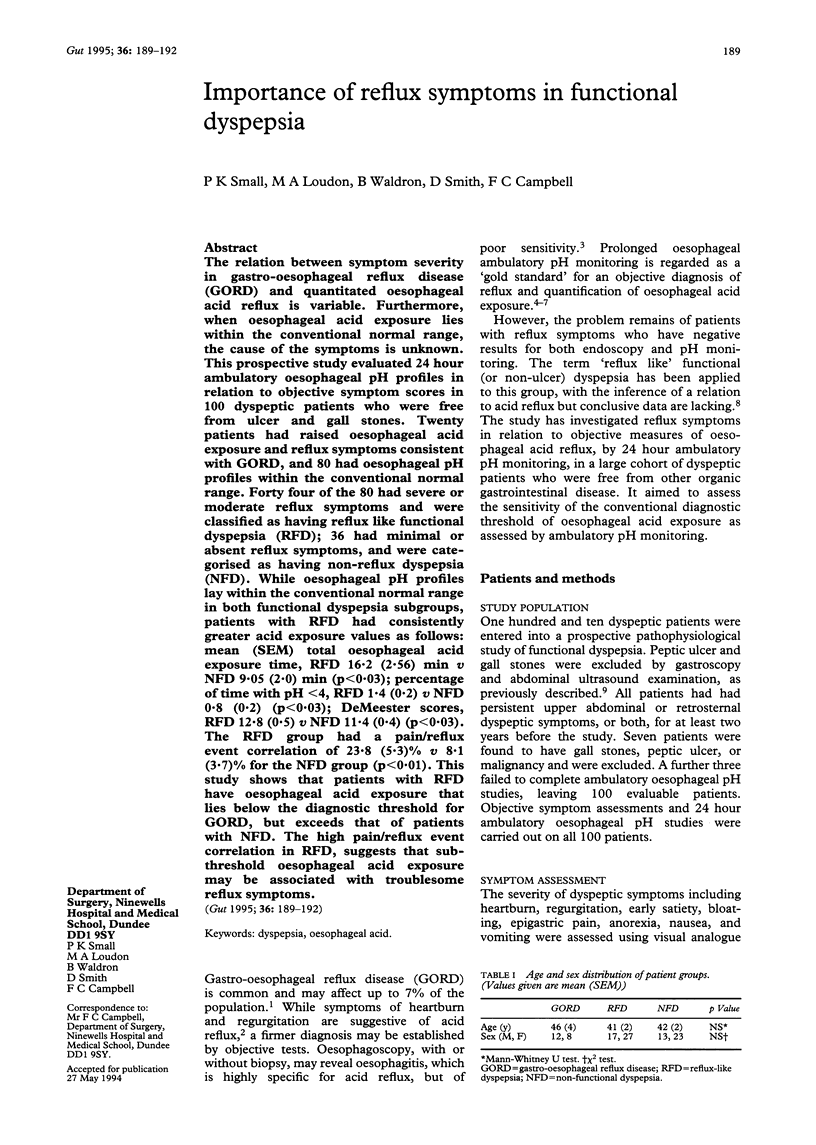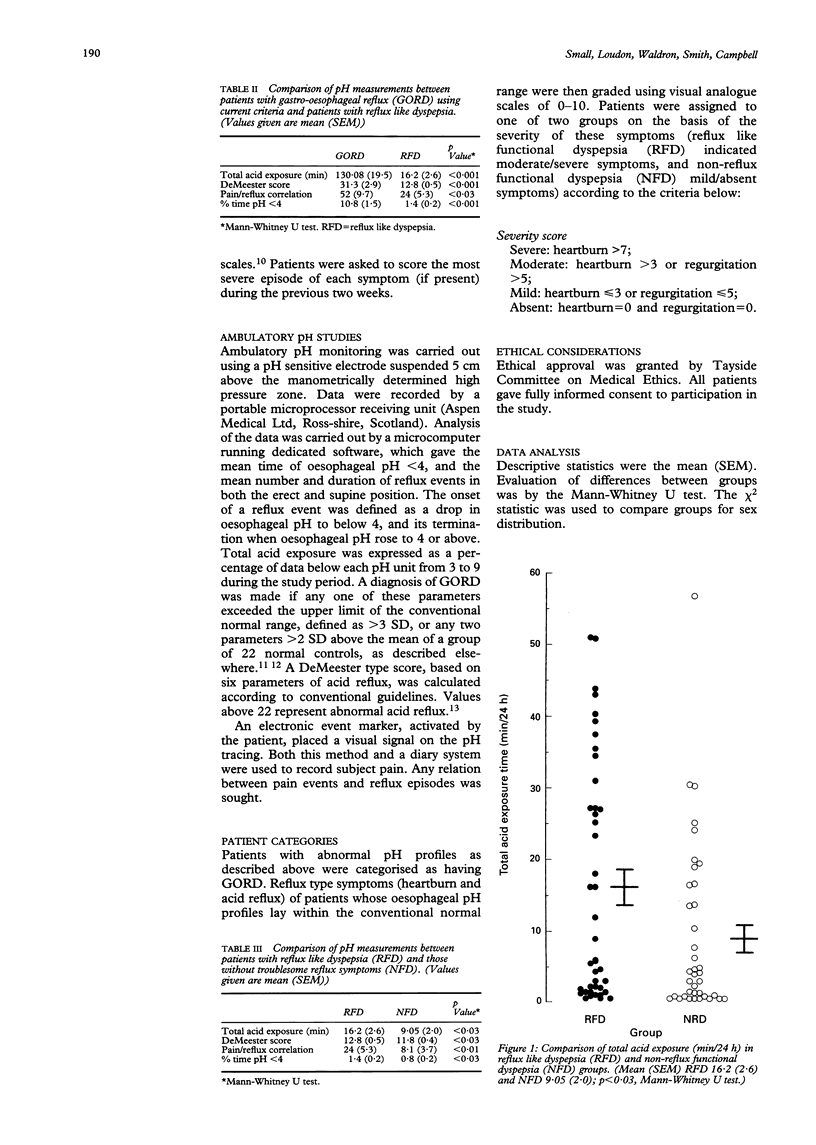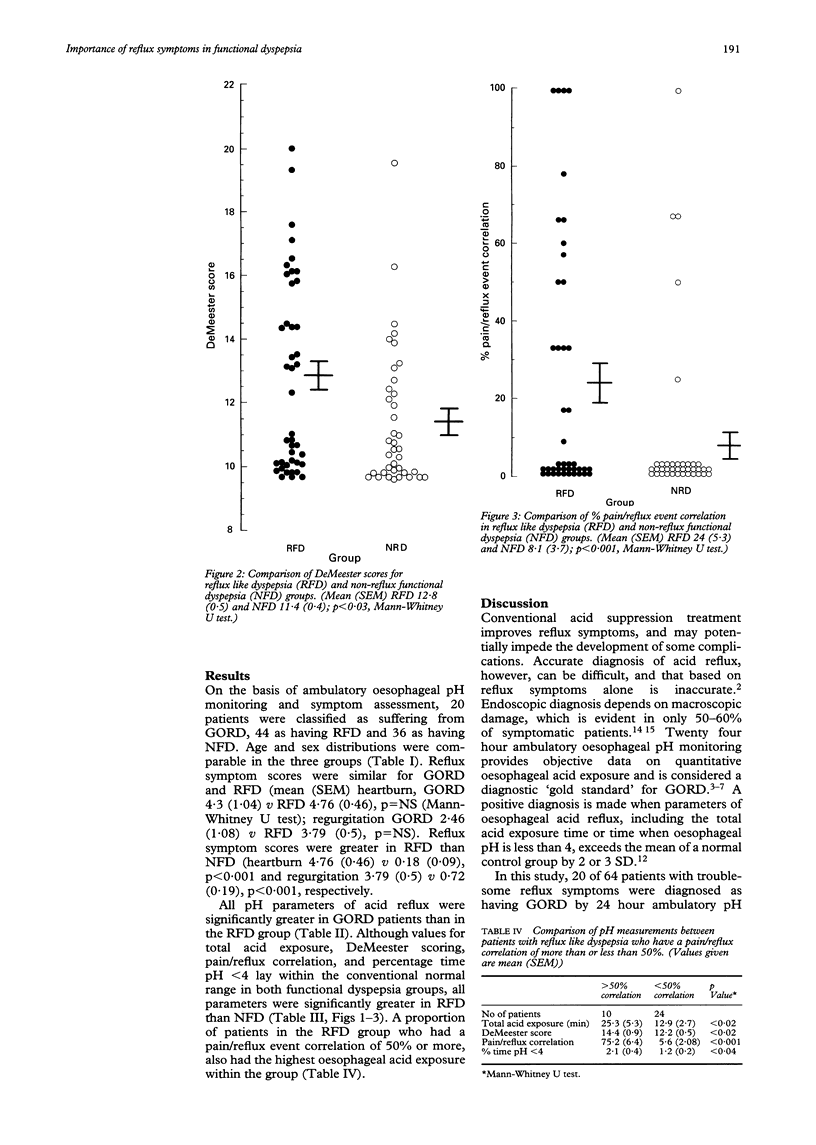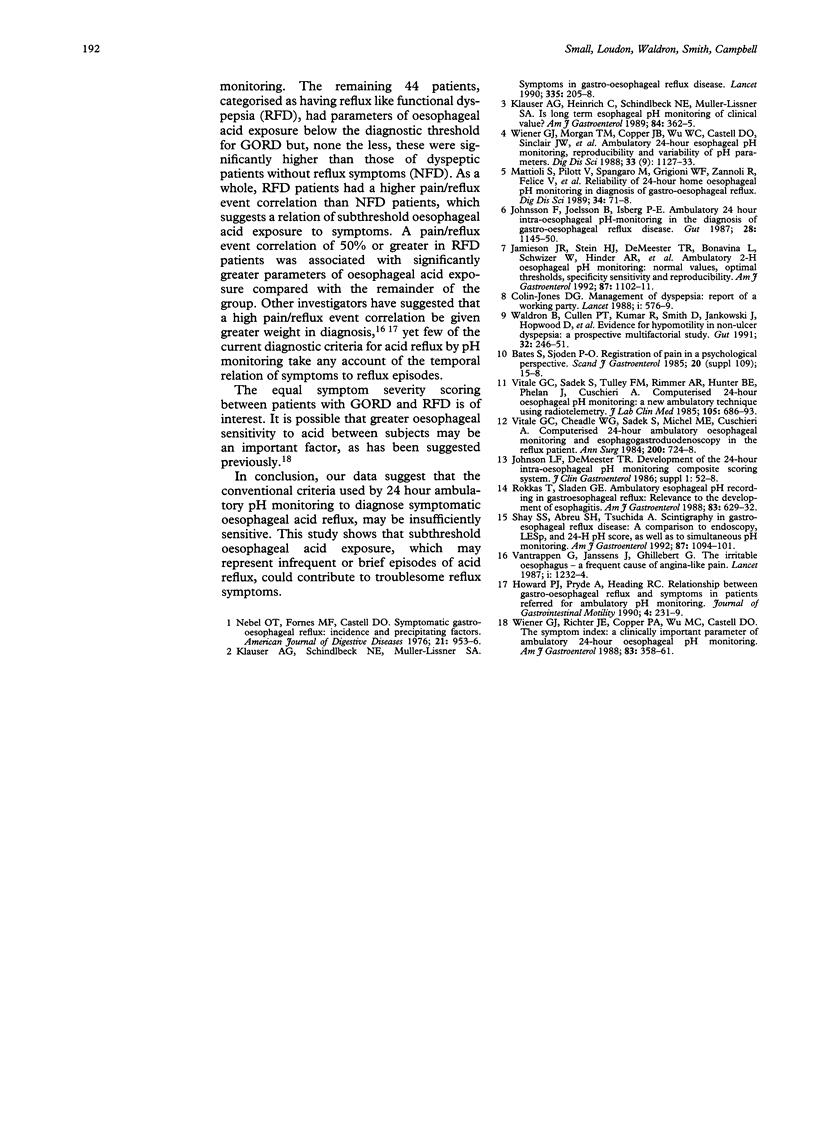Abstract
The relation between symptom severity in gastro-oesophageal reflux disease (GORD) and quantitated oesophageal acid reflux is variable. Furthermore, when oesophageal acid exposure lies within the conventional normal range, the cause of the symptoms is unknown. This prospective study evaluated 24 hour ambulatory oesophageal pH profiles in relation to objective symptom scores in 100 dyspeptic patients who were free from ulcer and gall stones. Twenty patients had raised oesophageal acid exposure and reflux symptoms consistent with GORD, and 80 had oesophageal pH profiles within the conventional normal range. Forty four of the 80 had severe or moderate reflux symptoms and were classified as having reflux like functional dyspepsia (RFD); 36 had minimal or absent reflux symptoms, and were categorised as having non-reflux dyspepsia (NFD). While oesophageal pH profiles lay within the conventional normal range in both functional dyspepsia subgroups, patients with RFD had consistently greater acid exposure values as follows: mean (SEM) total oesophageal acid exposure time, RFD 16.2 (2.56) min v NFD 9.05 (2.0) min (p < 0.03); percentage of time with pH < 4, RFD 1.4 (0.2) v NFD 0.8 (0.2) (p < 0.03); DeMeester scores, RFD 12.8 (0.5) v NFD 11.4 (0.4) (p < 0.03). The RFD group had a pain/reflux event correlation of 23.8 (5.3)% v 8.1 (3.7)% for the NFD group (p < 0.01). This study shows that patients with RFD have oesophageal acid exposure that lies below the diagnostic threshold for GORD, but exceeds that of patients with NFD. The high pain/reflux event correlation in RFD, suggests that subthreshold oesophageal acid exposure may be associated with troublesome reflux symptoms.
Full text
PDF



Selected References
These references are in PubMed. This may not be the complete list of references from this article.
- Bates S., Sjödén P. O. Registration of pain in a psychological perspective. Scand J Gastroenterol Suppl. 1985;109:15–18. doi: 10.3109/00365528509103928. [DOI] [PubMed] [Google Scholar]
- Jamieson J. R., Stein H. J., DeMeester T. R., Bonavina L., Schwizer W., Hinder R. A., Albertucci M. Ambulatory 24-h esophageal pH monitoring: normal values, optimal thresholds, specificity, sensitivity, and reproducibility. Am J Gastroenterol. 1992 Sep;87(9):1102–1111. [PubMed] [Google Scholar]
- Johnsson F., Joelsson B., Isberg P. E. Ambulatory 24 hour intraesophageal pH-monitoring in the diagnosis of gastroesophageal reflux disease. Gut. 1987 Sep;28(9):1145–1150. doi: 10.1136/gut.28.9.1145. [DOI] [PMC free article] [PubMed] [Google Scholar]
- Klauser A. G., Heinrich C., Schindlbeck N. E., Müller-Lissner S. A. Is long-term esophageal pH monitoring of clinical value? Am J Gastroenterol. 1989 Apr;84(4):362–366. [PubMed] [Google Scholar]
- Klauser A. G., Schindlbeck N. E., Müller-Lissner S. A. Symptoms in gastro-oesophageal reflux disease. Lancet. 1990 Jan 27;335(8683):205–208. doi: 10.1016/0140-6736(90)90287-f. [DOI] [PubMed] [Google Scholar]
- Management of dyspepsia: report of a working party. Lancet. 1988 Mar 12;1(8585):576–579. [PubMed] [Google Scholar]
- Mattioli S., Pilotti V., Spangaro M., Grigioni W. F., Zannoli R., Felice V., Conci A., Gozzetti G. Reliability of 24-hour home esophageal pH monitoring in diagnosis of gastroesophageal reflux. Dig Dis Sci. 1989 Jan;34(1):71–78. doi: 10.1007/BF01536157. [DOI] [PubMed] [Google Scholar]
- Nebel O. T., Fornes M. F., Castell D. O. Symptomatic gastroesophageal reflux: incidence and precipitating factors. Am J Dig Dis. 1976 Nov;21(11):953–956. doi: 10.1007/BF01071906. [DOI] [PubMed] [Google Scholar]
- Rokkas T., Sladen G. E. Ambulatory esophageal pH recording in gastroesophageal reflux: relevance to the development of esophagitis. Am J Gastroenterol. 1988 Jun;83(6):629–632. [PubMed] [Google Scholar]
- Shay S. S., Abreu S. H., Tsuchida A. Scintigraphy in gastroesophageal reflux disease: a comparison to endoscopy, LESp, and 24-h pH score, as well as to simultaneous pH monitoring. Am J Gastroenterol. 1992 Sep;87(9):1094–1101. [PubMed] [Google Scholar]
- Vantrappen G., Janssens J., Ghillebert G. The irritable oesophagus--a frequent cause of angina-like pain. Lancet. 1987 May 30;1(8544):1232–1234. doi: 10.1016/s0140-6736(87)92686-9. [DOI] [PubMed] [Google Scholar]
- Vitale G. C., Cheadle W. G., Sadek S., Michel M. E., Cuschieri A. Computerized 24-hour ambulatory esophageal pH monitoring and esophagogastroduodenoscopy in the reflux patient. A comparative study. Ann Surg. 1984 Dec;200(6):724–728. doi: 10.1097/00000658-198412000-00009. [DOI] [PMC free article] [PubMed] [Google Scholar]
- Vitale G. C., Sadek S., Tulley F. M., Rimmer A. R., Hunter B. E., Phelan J., Cuschieri A. Computerized 24-hour esophageal pH monitoring: a new ambulatory technique using radiotelemetry. J Lab Clin Med. 1985 Jun;105(6):686–693. [PubMed] [Google Scholar]
- Waldron B., Cullen P. T., Kumar R., Smith D., Jankowski J., Hopwood D., Sutton D., Kennedy N., Campbell F. C. Evidence for hypomotility in non-ulcer dyspepsia: a prospective multifactorial study. Gut. 1991 Mar;32(3):246–251. doi: 10.1136/gut.32.3.246. [DOI] [PMC free article] [PubMed] [Google Scholar]
- Wiener G. J., Morgan T. M., Copper J. B., Wu W. C., Castell D. O., Sinclair J. W., Richter J. E. Ambulatory 24-hour esophageal pH monitoring. Reproducibility and variability of pH parameters. Dig Dis Sci. 1988 Sep;33(9):1127–1133. doi: 10.1007/BF01535789. [DOI] [PubMed] [Google Scholar]
- Wiener G. J., Richter J. E., Copper J. B., Wu W. C., Castell D. O. The symptom index: a clinically important parameter of ambulatory 24-hour esophageal pH monitoring. Am J Gastroenterol. 1988 Apr;83(4):358–361. [PubMed] [Google Scholar]


